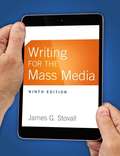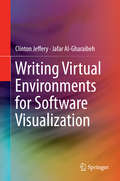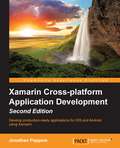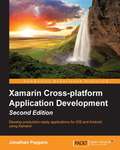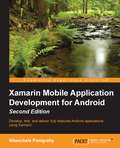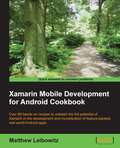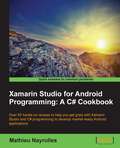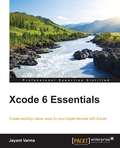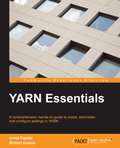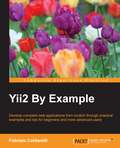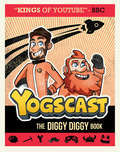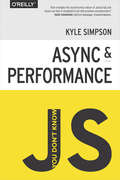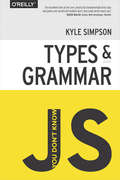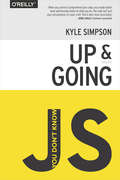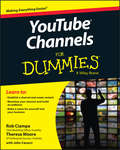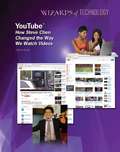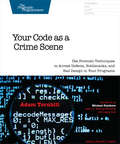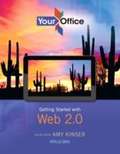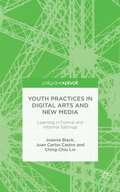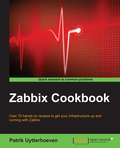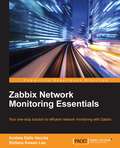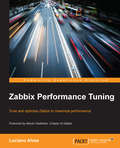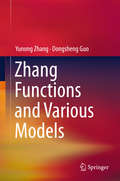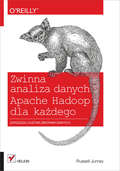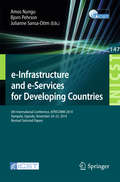- Table View
- List View
Writing For The Mass Media (Ninth Edition)
by James G. StovallA clear and effective introduction to media writing Writing for the Mass Media offers clear writing, simple organization, abundant exercises, and precise examples that give students information about media writing and opportunities to develop their skills as professional writers. With a focus on a converged style of media writing, and converting that style into real work, this ninth edition maintains its classic and effective text/workbook format while staying ahead of the curve and preparing students for their future careers. MyCommunicationLab is an integral part of the Stovall program. MediaShare allows students to post speeches and share them with classmates and instructors. Interactive videos provide students with the opportunity to watch and evaluate sample speeches. Online self-assessments and pre- and post-tests help students assess their comfort level with public speaking and their knowledge of the material.
Writing Virtual Environments for Software Visualization
by Clinton Jeffery Jafar Al-GharaibehWriting Virtual Environments for Software Visualization book describes the software for a networked, 3D multi-user virtual environment that allows users to create and share remotely visualizations of program behavior. Collaborative virtual environments such as World of Warcraft or Second Life are a popular way to share interactive internet experiences, but they are complex and difficult to create Software visualization is an area that may enable important advances in our ability to understand and reduce the costs of maintaining software. Applying the former technology to this problem area will be valuable to distributed and multi-institutional software development and educational users. The author covers the major features of collaborative virtual environments and how to program them in a very high level language. The book also examines the application of popular game-like software technologies.
Xamarin Cross-platform Application Development - Second Edition
by Jonathan PeppersIf you are a developer with experience in C# and are just getting into mobile development, this is the book for you. If you have experience with desktop applications or the Web, this book will give you a head start on cross-platform development.
Xamarin Cross-platform Application Development Second Edition
by Jonathan PeppersIf you are a developer with experience in C# and are just getting into mobile development, this is the book for you. If you have experience with desktop applications or the Web, this book will give you a head start on cross-platform development.
Xamarin Mobile Application Development for Android - Second Edition
by Nilanchala PanigrahyDevelop, test, and deliver fully-featured Android applications using Xamarin About This Book * Build and test multi-view Android applications using Xamarin.Android * Work with device capabilities such as location sensors and the camera * A progressive, hands-on guide to develop stunning Android applications using Xamarin Who This Book Is For If you are a C# developer who wants to develop Android apps and enhance your existing skill set, then this book is ideal for you. Good working knowledge of C#, .NET, and object-oriented software development is assumed. What You Will Learn * Build a multi-view, orientation-aware Android application with navigation * Lay out content using the LinearLayout, RelativeLayout, and TableLayout layout managers * Use a ListView (AdapterView) and Adapter to build a view that is populated from server data * Consume REST web service to perform GET, UPDATE, DELETE operation * Use Android SQLite for data persistence and caching * Capture the current location of a device, determine the street address, and integrate with the map app * Test, debug, and deploy an Android app In Detail Technology trends come and go, but few have generated the excitement, momentum, or long-term impact that mobile computing has. Mobile computing impacts people's lives at work and at home on a daily basis. Many companies and individual developers are looking to become a part of the movement but are unsure how to best utilize their existing skills and assets. The Xamarin suite of products provides new opportunities to those who already have a significant investment in C# development skills and .NET code bases, and would like to enter into this new, exciting world. This example-oriented guide provides a practical approach to quickly learn the fundamentals of Android app development using C# and Xamarin.Android. It will lead you through building an Android app step-by-step with steadily increasing complexity. Beginning with an overview of the Android and Xamarin platforms to provide you with a solid understanding of the underlying platform, we gradually walk through building and testing a Points of Interest Android app using C# and the Xamarin.Android product. You will learn to create ListView and add detail view to your Android application. You will handle application behaviors on orientation changes, before learning the different techniques to manage resources and layouts to support multiple screen sizes. You will then access a SQLite database in a cross-platform way and add location features to your application. Finally, you will add camera integration to your application and deploy your app to the various Android app stores. Style and approach An example-oriented, comprehensive guide to gain an understanding of both the Android and Xamarin platforms.
Xamarin Mobile Development for Android Cookbook
by Matthew LeibowitzOver 80 hands-on recipes to unleash full potential for Xamarin in development and monetization of feature-packed, real-world Android apps About This Book * Create a number of Android applications using the Xamarin Android platform * Extensively integrate your Android devices with other Android devices to enhance your app creation experience * A comprehensive guide packed with real-world scenarios and pro-level practices and techniques to help you build successful Android apps Who This Book Is For If you are a Xamarin developer who wants to create complete Android applications with Xamarin, then this book is ideal for you. No prior knowledge of Android development is needed, however a basic knowledge of C# and .NET would be useful. What You Will Learn * Install and use Xamarin.Android with Xamarin Studio and Visual Studio * Design an app's user interface for multiple device configurations * Store and protect data in databases, files, and on the cloud * Utilize lists and collections to present data to the user * Communicate across the network using NFC or Bluetooth * Perform tasks in the background and update the user with notifications * Capture and play multimedia, such as video and audio, with the camera * Implement In-App Billing and Expansion Files and deploy to the store In Detail Xamarin is used by developers to write native iOS, Android, and Windows apps with native user interfaces and share code across multiple platforms not just on mobile devices, but on Windows, Mac OS X, and Linux. Developing apps with Xamarin.Android allows you to use and re-use your code and your skills on different platforms, making you more productive in any development. Although it's not a write-once-run-anywhere framework, Xamarin provides native platform integration and optimizations. There is no middleware; Xamarin.Android talks directly to the system, taking your C# and F# code directly to the low levels. This book will provide you with the necessary knowledge and skills to be part of the mobile development era using C#. Covering a wide range of recipes such as creating a simple application and using device features effectively, it will be your companion to the complete application development cycle. Starting with installing the necessary tools, you will be guided on everything you need to develop an application ready to be deployed. You will learn the best practices for interacting with the device hardware, such as GPS, NFC, and Bluetooth. Furthermore, you will be able to manage multimedia resources such as photos and videos captured with the device camera, and so much more! By the end of this book, you will be able to create Android apps as a result of learning and implementing pro-level practices, techniques, and solutions. This book will ascertain a seamless and successful app building experience. Style and approach This book employs a step-by-step approach to Android app creation, explained in a conversational and easy-to-follow style. A wide range of examples are listed to ensure a complete understanding of how to deploy competent apps on the Android market.
Xamarin Studio for Android Programming: A C# Cookbook
by Mathieu NayrollesOver 50 hands-on recipes to help you get grips with Xamarin Studio and C# programming to develop market-ready Android applications About This Book * Create Android applications with C# and Xamarin * Reuse your Android application to develop iOS and Windows Phone applications * Leverage the easy-to-succeed recipes to exploit the latest Android releases and develop new applications Who This Book Is For If you have already developed an Android applications with Java and you now intend to use C# and Xamarin Studio's capabilities, or if you have never taken the dive into mobiles, then this book is for you. It would be helpful to have some C# experience so you follow the recipes in this book, though knowledge of Android is not required. What You Will Learn * Build a GUI for your Android applications * Explore Android activities and understand configuration changes * Manage multiscreens, icons, and multimedia in your applications * Start and bind Android services and create notifications * Create beautiful applications using the camera and animations * Effectively couple your phone's hardware with applications * Integrate advertisements and select the right advertisement providers for your applications In Detail Multiplatform applications have taken the development world by storm. This has revolutionized the selection of the right tools for the efficient development and deployment of applications. Xamarin studio is emerging as the preferred choice among .NET/C# developers. It enables them to design cross-platform applications using their favorite language and IDE. Xamarin studio is supported by the Mac OS and Windows platforms, and you can develop your own applications for iOS, Windows, or Android with its help. This book takes you through all the stages of application development, right from getting started with Xamarin and developing a GUI to putting up your application on the store. The recipes will help you in acquiring sufficient knowledge to go about creating applications. Starting with introducing Xamarin studio, its underlying technologies, and the Android ecosystem, the book goes on to cover the graphical aspects of creating Android applications. Moving on, you will learn more about data management with Android services. This is followed by techniques on how to interact with the Android OS and the phone's hardware, before finally concluding with mobile advertisements and Google Play. By the end of this book, you will have discovered all the specialties related to developing Android application with Xamarin Studio. Style and approach This book is organized around hands-on and practical recipes that focus on the development of Android applications using C# and Xamarin. Each recipe is easy to follow to help you progress efficiently through the book.
Xcode 6 Essentials
by Jayant VarmaThis book is aimed at developers who want to make applications for Apple devices with Xcode. iOS developers who have experience using other frameworks and languages can now migrate to Xcode and build creative, native apps.
YARN Essentials
by Nirmal Kumar Amol FasaleIf you have a working knowledge of Hadoop 1.x but want to start afresh with YARN, this book is ideal for you. You will be able to install and administer a YARN cluster and also discover the configuration settings to fine-tune your cluster both in terms of performance and scalability. This book will help you develop, deploy, and run multiple applications/frameworks on the same shared YARN cluster.
Yii2 By Example
by Fabrizio CaldarelliDevelop complete web applications from scratch through practical examples and tips for beginners and more advanced users About This Book * Improve your programming experience and become a full stack developer * Master real-life web applications, and create and manage four different projects * Step-by-step guidance to develop real-world web applications smoothly Who This Book Is For This book is for anyone who wants to discover and explore Yii Framework. Basic programming experience with PHP and object oriented programming is assumed. What You Will Learn * Understand basic concepts, along with the installation and customization of Yii * Discover models, controllers, and views--concepts applied in a web context--and how they are employed in Yii * Use ActiveRecord to manipulate a database * Add access control to your web application through authentication and authorization * Install and customize an advanced template for multiple applications in the same project * Create a RESTful Web Service to allow remote access to data * Develop a console application to launch a command in the console as an automated task (cron job) * Make code reusable through widgets and components and localize text messages to make a multilanguage web app In Detail Yii is a high-performance PHP framework best for developing Web 2.0 applications. It provides fast, secure, and professional features to create robust projects, however, this rapid development requires the ability to organize common tasks together to build a complete application. It's all too easy to get confused; this is where this book comes in. This book contains a series of practical project examples for developers starting from scratch. Each section contains the most relevant theories for every topic as you walk through developing each project, focusing on key aspects that commonly confuse users. The book starts with all the framework's basic concepts, such as controllers and views, to introduce you to Yii and creating your first application, a simple news reader. You will be learn to configure URL rules to make a pretty URL, essential for search engine optimization. Next, you will walk through Model and ActiveRecord, key concepts in database interaction. The second application you will develop is a reservation system that allows you to manage rooms, customers, and reservations. For this, you will use database connection through SQL and ActiveRecord. More complex than the first one, this application will introduce you to the advanced template of Yii 2, splitting the app into two parts: a frontend for all visitors and a backend for the admin. Finally, you will move on to the last two applications: one that allows connections from remote clients, through RESTful components of Yii 2, and another that creates and organizes automatic tasks using the console application structure of Yii 2. Style and approach This is a step-by-step guide with each topic introduced in the context of real-world applications, highlighting common cases where users may encounter difficulties.
Yogscast: The Diggy Diggy Book
by The YogscastYogscast is a wildly popular YouTube channel--with more than 4 BILLION views--that is made up of 20+ gamers who create hilarious videos, animations, and songs based on their favorite games.Drop your axe. Lower your sword. And open the ultimate, must-have book for gamers of all ages! The Diggy Diggy Book includes the best (and worst) jokes from the massively successful YouTube creators. Meet the Yogscast, see exclusive look inside YogTowers, become a JaffaQuest cadet, read the tourists guide to Datlof and more, so much more that we don't want to give away. (Yet!) If you've ever watched a Minecraft YouTube video, chances are you know who The Yogscast is. This is THE book for you.
You Don't Know JS: Async & Performance
by Kyle SimpsonNo matter how much experience you have with JavaScript, odds are you don't fully understand the language. As part of the "You Don't Know JS" series, this compact guide focuses on the new asynchronous features in JavaScript, which are often confusing to developers. You'll learn about promises, generators, and coroutines, all of which allow you to create more sophisticated single-page web applications that provide the features of a desktop application without tying up the user's browser.Like other books in this series, You Don't Know JS: Async & Performance dives into trickier parts of the language that many JavaScript programmers simply avoid. Armed with this knowledge, you can achieve true JavaScript mastery.
You Don't Know JS: Types & Grammar
by Kyle SimpsonNo matter how much experience you have with JavaScript, odds are you don't fully understand the language. As part of the "You Don't Know JS" series, this compact guide explores JavaScript types in greater depth than previous treatments by looking at type coercion problems, demonstrating why types work, and showing you how to take advantage of these features.Like other books in this series, You Don't Know JS: Types & Grammar dives into trickier parts of the language that many JavaScript programmers simply avoid or assume don't exist (like types). Armed with this knowledge, you can achieve true JavaScript mastery.With this book you will:Get acquainted with JavaScript's seven types: null, undefined, boolean, number, string, object, and symbolUnderstand why JavaSript's unique array, string, and number characteristics may delight or confound youLearn how natives provide object wrappers around primitive valuesDive into the coercion controversy--and learn why this feature is useful in many casesExplore various nuances in JavaScript syntax, involving statements, expressions, and other features
You Don't Know JS: Up & Going
by Kyle SimpsonIt's easy to learn parts of JavaScript, but much harder to learn it completely--or even sufficiently--whether you're new to the language or have used it for years. With the "You Don't Know JS" book series, you'll get a more complete understanding of JavaScript, including trickier parts of the language that many experienced JavaScript programmers simply avoid.The series' first book, Up & Going, provides the necessary background for those of you with limited programming experience. By learning the basic building blocks of programming, as well as JavaScript's core mechanisms, you'll be prepared to dive into the other, more in-depth books in the series--and be well on your way toward true JavaScript.With this book you will:Learn the essential programming building blocks, including operators, types, variables, conditionals, loops, and functionsBecome familiar with JavaScript's core mechanisms such as values, function closures, this, and prototypesGet an overview of other books in the series--and learn why it's important to understand all parts of JavaScript
YouTube Channels For Dummies
by John Carucci Theresa Moore Adam Wescott Stan Muller Rob CiampaCreate content and build a YouTube channel like a pro Written by a successful YouTube channel producer, YouTube Channels For Dummies shows you how to create content, establish a channel, build an audience, and successfully monetize video content online. Beginning with the basics, it shows you how to establish a channel, join a partner program, and develop a content plan. Next, you'll gain insight into how to create content that builds a channel, enhance the viral nature of a video, encourage subscriptions, and earn repeat views. If that weren't enough, you'll go on even further to learn how to get the word out about your channel and discover ways to enhance your potential profits. That's a lot of info--but it's easily digestible and simple to put into practice when it's provided in the accessible and trusted For Dummies format. YouTube is the third most-visited website on the Internet, making it prime real estate for anyone seeking customers, celebrity, or education. If you want to harness this irresistible platform and reach a global platform, YouTube Channels For Dummies makes it easy. In no time, you'll have the know-how to create a YouTube channel with regular subscribers who watch, re-watch, and share your videos. Includes ten easy tips for growing a raptured YouTube audience Details how to enhance the viral nature of a video Shows you how to create and maintain a YouTube channel that generates views and revenue Written by the producer of a leading YouTube channel
YouTube®: How Steve Chen Changed the Way We Watch Videos
by Celicia ScottYou probably watch music videos, movie trailers, or funny clips on YouTube--but just a few years ago, YouTube was only an idea a few friends shared. One of those friends was Steve Chen. Learn about the beginning of one of the most important websites ever created. Discover the story of how Steve helped to start the biggest video site on the Internet.
Your Code as a Crime Scene: Use Forensic Techniques to Arrest Defects, Bottlenecks, and Bad Design in Your Programs
by Adam TornhillJack the Ripper and legacy codebases have more in common than you'd think. Inspired by forensic psychology methods, you'll learn strategies to predict the future of your codebase, assess refactoring direction, and understand how your team influences the design. With its unique blend of forensic psychology and code analysis, this book arms you with the strategies you need, no matter what programming language you use.Software is a living entity that's constantly changing. To understand software systems, we need to know where they came from and how they evolved. By mining commit data and analyzing the history of your code, you can start fixes ahead of time to eliminate broken designs, maintenance issues, and team productivity bottlenecks. In this book, you'll learn forensic psychology techniques to successfully maintain your software. You'll create a geographic profile from your commit data to find hotspots, and apply temporal coupling concepts to uncover hidden relationships between unrelated areas in your code. You'll also measure the effectiveness of your code improvements. You'll learn how to apply these techniques on projects both large and small. For small projects, you'll get new insights into your design and how well the code fits your ideas. For large projects, you'll identify the good and the fragile parts.Large-scale development is also a social activity, and the team's dynamics influence code quality. That's why this book shows you how to uncover social biases when analyzing the evolution of your system. You'll use commit messages as eyewitness accounts to what is really happening in your code. Finally, you'll put it all together by tracking organizational problems in the code and finding out how to fix them. Come join the hunt for better code!What You Need:You need Java 6 and Python 2.7 to run the accompanying analysis tools. You also need Git to follow along with the examples.
Your Office: Getting Started with Project Management Using Microsoft Project 2013
by Amy S. Kinser Kristyn JacobsonThis book provides an overview of key project management topics and skills, using Microsoft Project 2013 to give students hands-on learning.
Youth Practices in Digital Arts and New Media: Learning in Formal and Informal Settings
by Joanna Black Juan Carlos Castro Ching-Chiu LinThe authors examine youths' practices in digital culture affecting social change, pedagogy, and creative learning practices. Knowledge about these practices is discussed, in which learning, knowledge sharing, distinct social contexts, pedagogical relationships, and artistic creative inquiry are examined in diverse formal and informal environments.
Zabbix Cookbook
by Patrik UytterhoevenIf you have some experience with Zabbix and wish to take your infrastructure to the next level, then this book is for you. Before you start with Zabbix, or monitoring in general, it is best to have some basic Linux knowledge and a good understanding of snmp, virtualization, and scripting.
Zabbix Network Monitoring Essentials
by Andrea Dalle Vacche Stefano Kewan LeeIf you are an experienced network administrator looking for a comprehensive monitoring solution that will keep a watchful eye on networks, then this book is for you.
Zabbix Performance Tuning
by Luciano AlvesThis book is aimed at Zabbix administrators who want to learn how to improve the performance of the Zabbix system. Basic knowledge of Zabbix's components and features is assumed.
Zhang Functions and Various Models
by Yunong Zhang Dongsheng GuoThis book focuses on solving different types of time-varying problems. It presents various Zhang dynamics (ZD) models by defining various Zhang functions (ZFs) in real and complex domains. It then provides theoretical analyses of such ZD models and illustrates their results. It also uses simulations to substantiate their efficacy and show the feasibility of the presented ZD approach (i. e. , different ZFs leading to different ZD models), which is further applied to the repetitive motion planning (RMP) of redundant robots, showing its application potential.
Zwinna analiza danych. Apache Hadoop dla ka?dego
by Russell JurneyDu?e zbiory danych dla ka?dego! W dobie Big Data klasyczne podej?cie do analizy danych nie przynosi ju? po??danych wyników. Skuteczna analiza gigantycznych zbiorów informacji, wyci?ganie interesuj?cych wniosków i prezentowanie ich w przejrzystej formie u?ytkownikowi wymagaj? mnóstwa czasu i ?rodków. Zastanawiasz si?, jak podej?? do tego problemu, by zminimalizowa? ryzyko niepowodzenia? Na to i wiele innych pyta? odpowiada ta fantastyczna ksi??ka.Dzi?ki niej dowiesz si?, jak zaprz?c platform? Hadoop do w?asnych celów. Skorzystasz z prostych narz?dzi, takich jak j?zyk Python, biblioteka D3.js oraz Apache Pig, i zastosujesz zwinne podej?cie do problemu, by osi?gn?? zaskakuj?ce efekty. Ponadto przekonasz si?, jak ?atwo mo?na publikowa? dane w MongoDB, stosowa? wyszukiwark? ElasticSearch oraz wykorzysta? potencja? chmur obliczeniowych. Nauczysz si? tak?e wizualizowa? dane na wykresach, prognozowa? oraz podejmowa? w?a?ciwe dzia?ania. Ksi??ka ta jest doskona?? lektur? dla wszystkich osób stoj?cych przed problemem skutecznej pracy z ogromnymi zbiorami danych.Dzi?ki tej ksi??ce: poznasz najlepsze narz?dzia do przetwarzania zbiorów danych wykorzystasz mo?liwo?ci j?zyka Python sprawdzisz mo?liwo?ci chmur obliczeniowych b?yskawicznie wyszukasz dane za pomoc? ElasticSearch zwizualizujesz dane z u?yciem D3.jsZwinnie rozwi?? problemy z du?ymi zbiorami danych!„Przy tak du?ej popularno?ci zagadnie? Big Data i Data Science, lektura praktycznego instrukta?u budowy aplikacji analitycznych jest mocno od?wie?aj?ca. Russel Jurney wprowadza nas, ma?ymi porcjami implementacji, w swoj? filozofi? zwinno?ci w dziedzinie analizy i aplikacyjnego wykorzystywania danych.”Mat Kelcey, matpalm.com
e-Infrastructure and e-Services for Developing Countries
by Amos Nungu Bjorn Pehrson Julianne Sansa-OtimThis book constitutes the thoroughly refereed proceedings of the 6th International Conference on e-Infrastructure and e-Services for Developing Countries, AFRICOMM 2014, held in Kampala, Uganda, November 24-25, 2014. The 31 revised full papers were carefully selected from 57 submissions and cover topics such as communication infrastructure, health, IoT, cloud computing and TVWS, ICT4D applications, access to information, and ICT4D miscellaneous.
